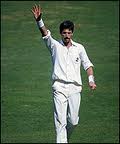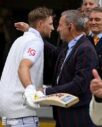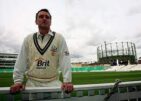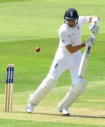Richard Hadlee against West Indies
Gareth Bland |
Sir Richard Hadlee is unquestionably the greatest all-round cricketer New Zealand has ever produced. Knighted for his services to the game during his valedictory tour of England in 1990, he is now his country’s eminence grise, a man with an unimpeachable reputation at home and abroad. His name is also inextricably linked to the great age of the all-rounder, an era where he strutted the world stage vying for the top spot with Ian Botham, Imran Khan and Kapil Dev. The elder of the four, Hadlee played the least number of Test matches, 86, in a career spanning seventeen years.
In an earlier feature, I examined the Test match career of another of
the big four – Sir Ian Botham – against the mightiest foe of the era, West Indies. The England all-rounder’s figures were much less impressive against Caribbean opposition but, it is safe to conclude, there were sufficient mitigating circumstances for us to be able to reinterpret the glaring questions raised by that notable gap in his illustrious cv. What then of Richard Hadlee and his record against the teams of Clive Lloyd and Viv Richards? If Botham’s career against the best of his era is to be put under the microscope then so too must Hadlee, as one of his most celebrated contemporaries, be scrutinised.
Hadlee played half the number of Test matches – 10 – against West Indies as Botham, a reflection of New Zealand’s sadly less esteemed status during the era and their concomitant inability to secure full five Test rubbers. Nevertheless, Hadlee played in three Test series against them. The first was at the dawn of the Lloyd outfit’s rise to global preeminence in the early months of 1980; the second was in the Caribbean as Richards inherited the mantle of leadership from Clive Lloyd, and the third came during 1986/87 when a frazzled and grumpy Windies touring party arrived in New Zealand. That team, jaded from a Pakistani tour and two one day internatonal tournaments in Australia where they finished empty handed, was the last West indian team to feature Garner, Gomes and Holding. So, interestingly, each of Hadlee’s three series against West Indies came at pivotal moments in the development of the Lloyd and Richards machines.
Hadlee’s debut series with Clive Lloyd’s team came at home, as did the last some seven years later. Like the the 1986/87 series West Indies arrived in New Zealand at the conclusion of an Australian tour. Similarly, Lloyd’s 1980 tourists gave the impression of not really wanting to be there, as did Richards’ squad in early 1987. The 1979/80 tour is most often remembered for Michael Holding kicking the stumps out of the ground in Dunedin, and for Colin Croft’s shameful shoulder barging of Umpire Fred Goodall in Christchurch. Newly minted world champions in the limited overs format, Lloyd and subsequent team managers, most notably Jackie Hendricks, knew that such surliness could never surface again if the team was to achieve its undoubted potential. In terms of Hadlee’s personal performance, his figures are revealing.
At the age of 28, in his first Test match against West Indies, Hadlee had the game of his life. In the first West Indian innings he took 5/34 and then followed it up with 6/68 in the second. In a game where the highest team total was New Zealand’s first innings 249, the home side reached the finish line with only one wicket to spare having only needed 104 for victory. It had been a thrillingly close finish and Hadlee added a first innings 51 with the bat to his 11 wicket haul. The drawn second Test at Christchurch saw Hadlee chalk up his maiden hundred coming in at number eight. It is not a century that is particularly close to his heart, though, as the antics of Croft and Lloyd forever sullied the experience, darkening what Hadlee calls his “hollow hundred”.
To watch the footage of Lloyd refusing to take the initiative and walk over to umpire Goodall is enough to reject totally the Cuddly Clive image he was allowed to cultivate subsequently. Eventually, Goodall strode over to the West Indies skipper who then point blank refused to admonish Croft. Speaking to Richie Benaud some years later, Hadlee claimed that the Windies had given up during his century and referred to the series as “the sour summer”.
In the final game in Auckland the Kiwis held out to claim the series 1-0, the only series defeat the West Indians would endure until Mark Taylor’s Australians arrived in the Caribbean fifteen years later. With his smooth, economical run up and delivery stride which drew him tight to the stumps, Hadlee had arrived as a genuinely world class strike bowler. In the first Test victory seven of Hadlee’s eleven victims fell leg before wicket. Even in a side which was lacking Viv Richards this was a staggering statistic, as the Windies team still contained Greenidge, Haynes, Lawrence Rowe, Kallicharran, Lloyd and Collis King.
In the three Tests Hadlee claimed 19 wickets at 19 a piece. With two five wicket hauls and a ten wicket match in Dunedin, Hadlee was also miserly, only conceding 2.23 per over. His maiden Test hundred inflated his series average to give him a mean of 44.50 where, remarkably, he struck his runs at a rate of 83.56 per hundred balls. The next time Hadlee would cross swords with the West Indians was in the Caribbean in early 1985. In a four match series, away from home and in very different conditions, the tourists were beaten 2-0.
The Kiwis held out in the opening two encounters to achieve parity, but were heavily beaten by ten wickets in the remaining two. Hadlee, unsurprisingly, was his country’s leading wicket taker with 15 scalps but it was Ewen Chatfield who took the only five wicket haul for the side in the Tests with 6/73 in Trinidad. Hadlee’s wickets came at 27.26 a piece and at a strike rate of 57.2. With the bat he failed to truly come to life as he had done on home soil five years earlier, scoring 137 at 22.83. Even so, his unbeaten 39 in Trinidad proved invaluable as it helped secure the draw. The bowler of the series, though, was Malcolm Marshall, then 27 and approaching the very peak of his powers. Hadlee finished the series as the second highest wicket taker on either side, twelve behind Marshall who ended the summer on 27.
During that Caribbean summer it was apparent Lance Cairns was past his best and the New Zealanders were also without Martin Snedden. Ewen Chatfield gave his all but it was clear New Zealand was lacking the firepower to back Hadlee up as spearhead. The experienced Gary Troup, the left arm seamer, failed to make headway and Derek Stirling, though sharp, proved erratic. It was the lack of back up that has led to accusations of defensive bowling by Hadlee on that particular tour. In his autobiography All Round View Imran Khan wrote of Hadlee “I also was told by the West Indians that when Hadlee toured the Caribbean, he was not the same attacking bowler they feared from county cricket”.
That may be an unduly harsh view and maybe Hadlee was adjusting to circumstances as he saw them. Even so, of his performance on that tour Wisden observed “Richard Hadlee confirmed his standing as a fast bowler of genuine class, but, unlike Marshall, he lacked support of similar quality”. Moreover, he did not look like a defensive bowler on the seaming surface in Trinidad during the opening morning of the series. Attacking the batsmen, he ripped out Haynes and Gomes for ducks to reduce the home side to 9/2 before Greenidge and Richardson countered. Additionally, Hadlee’s strike rate during that series certainly stands comparison with the 54.6 of Michael Holding and he was much more penetrative that Joel Garner, who endured a lean series and ended with a wicket every 81.8 balls.
By late 1985 and on into 1986 Hadlee seemed, at 35, to be getting better with age. In the 1985/86 series with Australia he took a career best 9/52 in the opening Test at Brisbane and finished the three match series with 33 wickets at an astonishing 12.15, together with 111 runs at 27.75. Crossing the Tasman for the return three Test series, Hadlee claimed 16 wickets at 24.18 and scored 105 runs at 52.50. In the 1986 English summer Hadlee was more than at home at Lord’s, Trent Bridge and The Oval as he took 19 wickets at 20.52 and chipped in with 93 runs at 31.00.
In the New Zealand summer of 1986/87 Hadlee prepared for battle with the West Indians for the third and final time in his career. In a series where Jeremy Coney’s men came from behind to draw the series 1-1 in the final game in Christchurch, Hadlee claimed 17 wickets at 20.82, including a decisive 6/50 in West Indies’ first innings of 100 on the opening morning of the final Test. Unlike Holding and Garner, who called it quits at different points during this series, Richard Hadlee still had some fuel left in the tank. Enough, in fact, to see him through to 1990 when he reached the age of 39.
In his 10 Test matches against West Indies, Richard Hadlee has a record that compares favourably with his exalted contemporaries Botham, Imran and Kapil Dev. In those Tests he took 51 wickets at 22.03, with four five wicket innings and a ten wicket match. Moreover, he achieved this at a strike rate of 49.1 and at an economy rate of 2.69 per over. Strikingly, Hadlee’s figures against the Windies compare favourably with his overall career figures. All told he claimed 431 Test match wickets at 22.29, just a fraction higher than his West Indian average. Moreover, he took a wicket every 50.8 balls throughout his Test career, just 1.7 deliveries more than against Caribbean opposition. Throughout his Test career he conceded 2.63 runs per over, virtually the same figure as against West Indies alone.
With the bat, too, the Hadlee vital statistics against sides led by Lloyd and Richards stack up favourably when compared with his overall career tally. A Windies mean average of 32.41 is a significant improvement on his career 27.16, while he struck his runs at a rate of 53.21 per hundred balls, just four runs lower than his overall 57.34. He may have been the least technically adept of the four all-rounders with the bat, Sir Richard being more of a flashing blade in the Flintoff mould than a technically adroit middle order specialist of the kind Imran became in his later career. He did, however, have the ability to counter attack dangerously and score his runs rapidly.
It is for his bowling that he will be forever remembered, however. As Imran Khan remarked in 1988 “over the years Hadlee has perfected his control to such an extent that he is probably the most dangerous bowler on a greentop that there has ever been. He must be one of the best bowlers of all time. For match after match, for many years now, he has been responsible for carrying the New Zealand attack”. His career against the West Indies, though comparatively short, shows that he did not baulk when it came to carrying his country when faced with the toughest challenge a cricketer of his generation could face. Unlike Ian Botham he was never burdened with his country’s captaincy and he made his debut against West Indies at an age – just months shy of 29 – when Botham had already played 14 turbulent Test matches against them. However, unlike Botham, Hadlee got better with age and with experience, while the England man, sadly, went into terminal decline just as Hadlee was destroying the Australians at Brisbane in late 1985.





Leave a comment